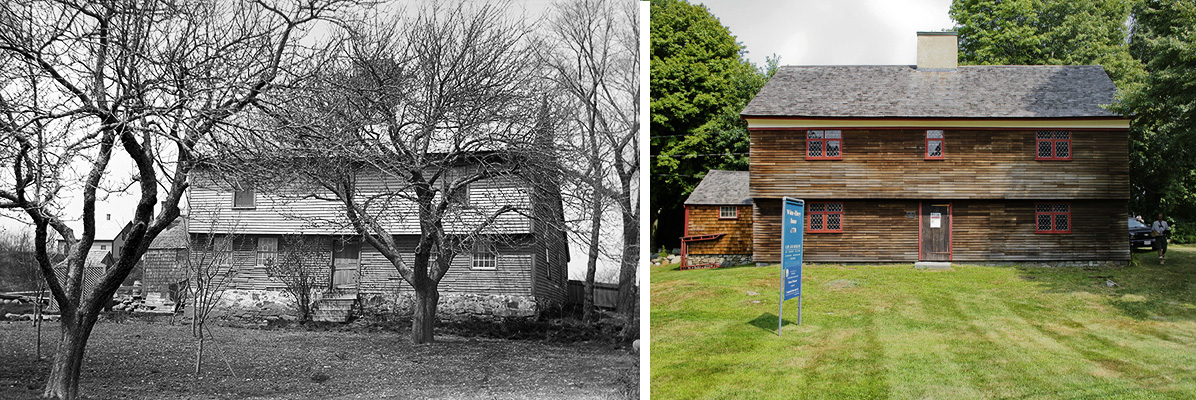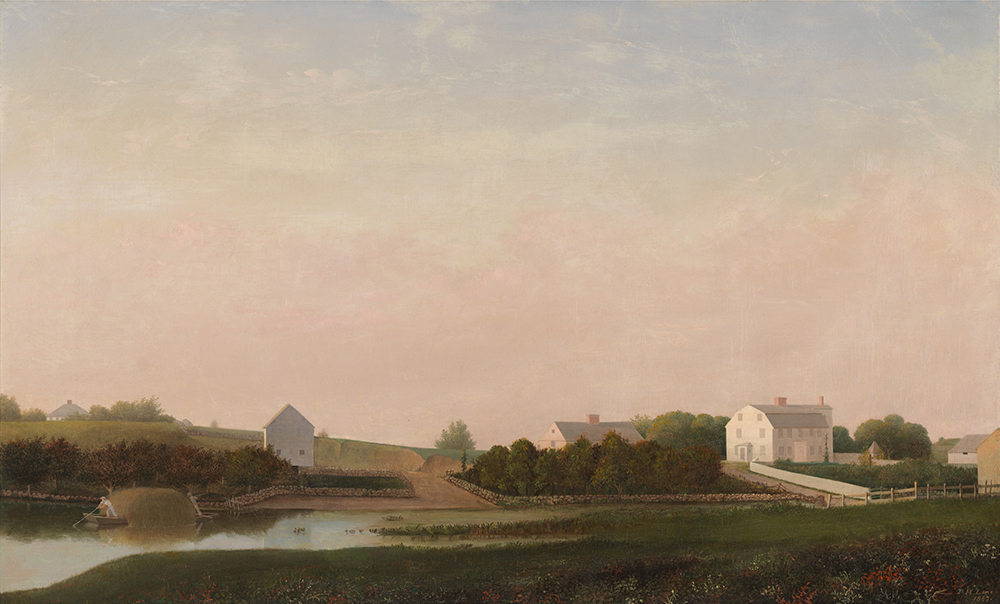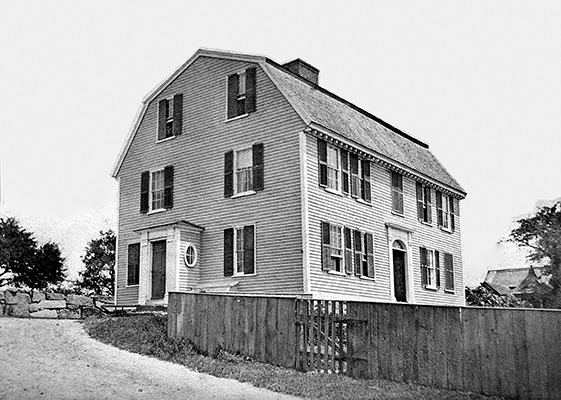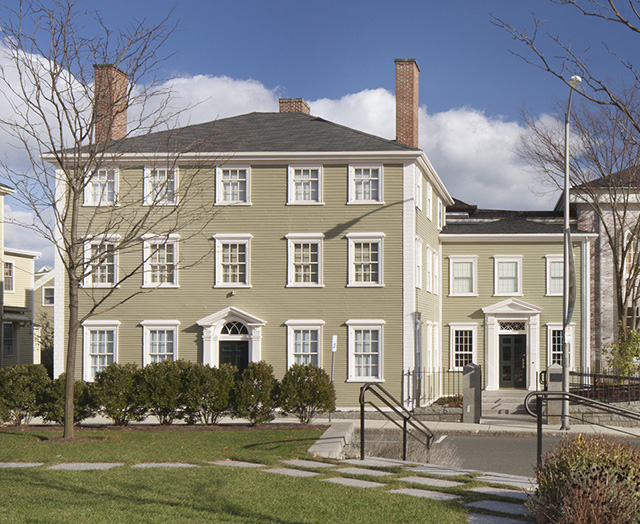Historic Properties
The Museum owns and maintains four unique historic structures: The White-Ellery House (1710); The Babson-Alling House (c.1740); an early New England barn (c. 1740); and the Captain Elias Davis House (c. 1799-1804). Together these buildings provide visitors with unique and thought-provoking points of entry into the social and economic history of this region over the past 400 years. Three of these buildings form part of the Cape Ann Museum Green and are integral to the Museum's new contemporary art initiatives.
The White-Ellery House (1710)

The White-Ellery House then and now. Photo at left by Joseph H. Clark, 1889, collection of the Cape Ann Museum Archives.
The White-Ellery House is located at 245 Washington Street in Gloucester at the Cape Ann Museum Green. The House has been owned by the Museum since 1947 and is one of just a handful of First Period structures in the region exhibiting much of its original interior detailing. The White-Ellery is commonly known as a “saltbox” and features an integral lean-to roof that spans the length of the structure. The massive central chimney that once serviced six fireplaces remains intact, as do several examples of early plaster work, some of which exhibits decorative painting. Architectural historian Abbott Lowell Cummings sited the White-Ellery House numerous times in his book The Framed Houses of Massachusetts Bay, 1625–1725, calling out, among other features, the front staircase, which he noted as being perhaps the most highly developed of the period in Eastern Massachusetts.
The White-Ellery House was used first as a parsonage for the Reverend John White. Between 1740 and 1947, it was occupied by six generations of the Ellery family; early on the house was used as a tavern and sometimes as the meeting place for town officials. Prior to the American Revolution, the neighborhood surrounding the White-Ellery House was the Town Green, center of the community and home to the wealthiest families. History tells us that there were few families of wealth on Cape Ann during this early period who did not keep slaves or who did not profit as a result of slavery, and the early Ellerys and their neighbors were no exception.
In 1947, the White-Ellery House was lifted off its original foundation and moved approximately 100 yards to make way for Route 128. The Cape Ann Museum maintains the structure as a study house and for educational and contemporary art programming.
The Babson-Alling House (c.1740)


(left) Fitz Henry Lane (1804–1865), View of the Babson and Ellery Houses, Gloucester, 1863, oil on canvas (22 x 36 in.), signed and dated lower right: F H. Lane 1863, Cape Ann Museum, Gloucester, Mass., Gift of Roger W. Babson, 1937 [779.02]; (right) The Babson-Alling House, photographed by Corliss & Ryan in 1882, collection of the Cape Ann Museum Archives.
The Babson-Alling House was acquired by the Cape Ann Museum in 2019, having been in private ownership since its construction around 1740. While just 50 years separate the house from the nearby White-Ellery House, the Babson-Alling House exhibits a sense of refinement within its rooms that is absent in the earlier structure. Writing in the Pencil Points architectural monograph series in October 1934, Stuart Bartlett heralded the Babson-Alling House for having “one of the most beautiful all-paneled rooms in the State (and one of the two still remaining upon Cape Ann!) with a most interesting staircase.” With its distinctive gambrel-roof and yellow clapboard-clad exterior, the Babson-Alling House has long been a landmark for those entering Gloucester and Cape Ann.
The Babson-Alling House was first owned by the Allen family and during the early 1800s came into the ownership of the Babsons. Early members of the Babson family were engaged in mercantile pursuits. However, by the mid-19th century they were making their living as farmers, maintaining gardens in front of their home and grazing and haying fields behind it. By the end of the Civil War, several members of the family left Cape Ann, headed for California and the promise of new opportunities. Among them were Maria Babson and her sister Emma (Babson) Friend who had grown up in the Babson-Alling House. When they left Gloucester around 1864 they took with them oil paintings done by Fitz Henry Lane capturing their family homestead on canvas.
The Babson-Alling House sits on its original foundation facing to the south; the gardens which once graced the front yard were ploughed under when Route 128 was constructed.
An Early New England Barn (c.1740)

Located between the White-Ellery House and the Babson-Alling House, the third historic structure owned by the Cape Ann Museum is a 3-bay barn. Like the Babson-Alling House, the structure sits on its original foundation. Its frame is made of wood that was readily available in the area during Colonial times: hemlock, oak and eastern white pine. The frame was joined using techniques brought over from England by early settlers.
Over the decades the barn has served many purposes including the storage of firewood and hay. Ownership of the structure ran with the Babson-Alling property from c. 1740 through the mid-20th century. Given the amount of development and change that has taken place in the neighborhood surrounding it, the barn is a remarkable survivor.
Stabilization of the barn was undertaken in 2018 with the support of the City of Gloucester’s Community Preservation Act grant program.
The Captain Elias Davis House (c.1799–1804)


The Davis House then and now. (left) Photographed by Leon Abdalian, c. 1930, collection of the Cape Ann Museum Archives; (right) photographed by Steve Rosenthal, 2014 (detail).
The Captain Elias Davis House, located in Gloucester’s downtown neighborhood, was constructed between 1799 and 1804 and has been the headquarters of the Cape Ann Museum since 1923. The House was built by “housewright” Jacob Smith who relied on architectural pattern books in his work and who is also credited with also building Gloucester’s Universalist Meeting House (c.1805).
Elias Davis and Lucy Haskell Davis, the original occupants of the Davis House, were representative of Gloucester families who moved from the Town Green and surrounding areas to the Harbor Village in the years following the American Revolution. With the move, families like the Davises became heavily engaged in maritime pursuits, most importantly foreign shipping and the fishing industry. Capt. Davis, like many of his peers, was involved in the “triangular trade” which brought salted fish from New England to the Caribbean where it was fed to enslaved people. Molasses was brought back to New England where it was made into rum for export to Europe.
The Davis House exhibits a mix of late Georgian and Federal detailing inside and out; recently interior spaces have been enhanced with period appropriate wall coverings and carpeting. The first floor of the Davis House is furnished and it share with visitors through guided tours.